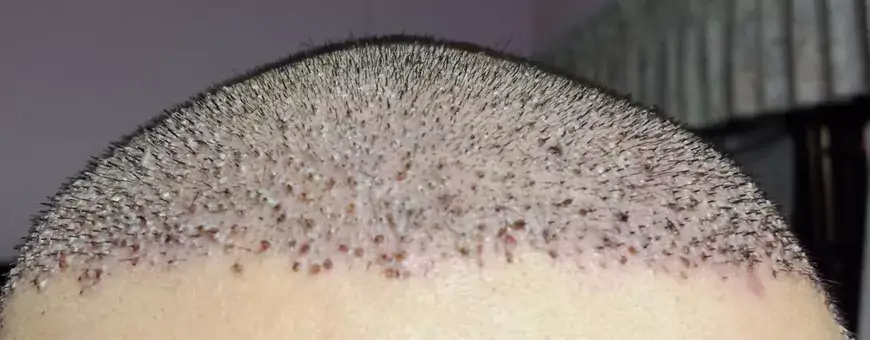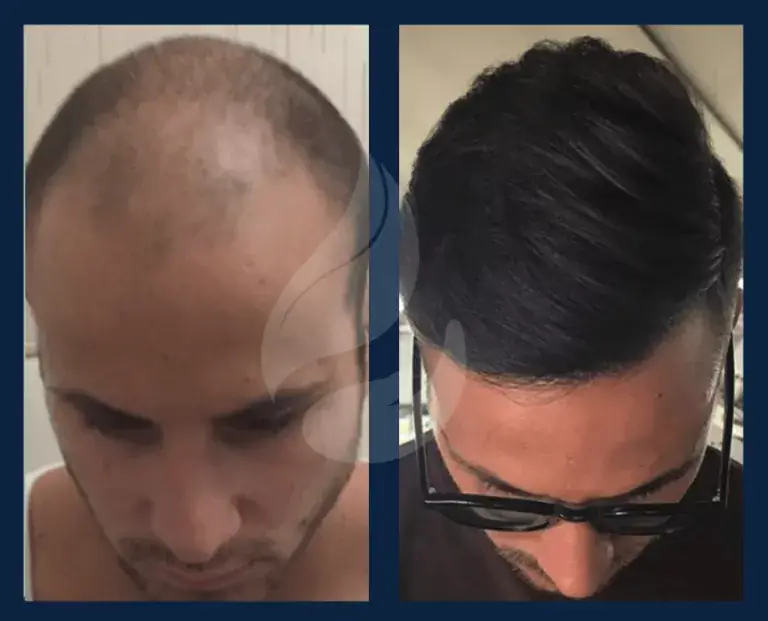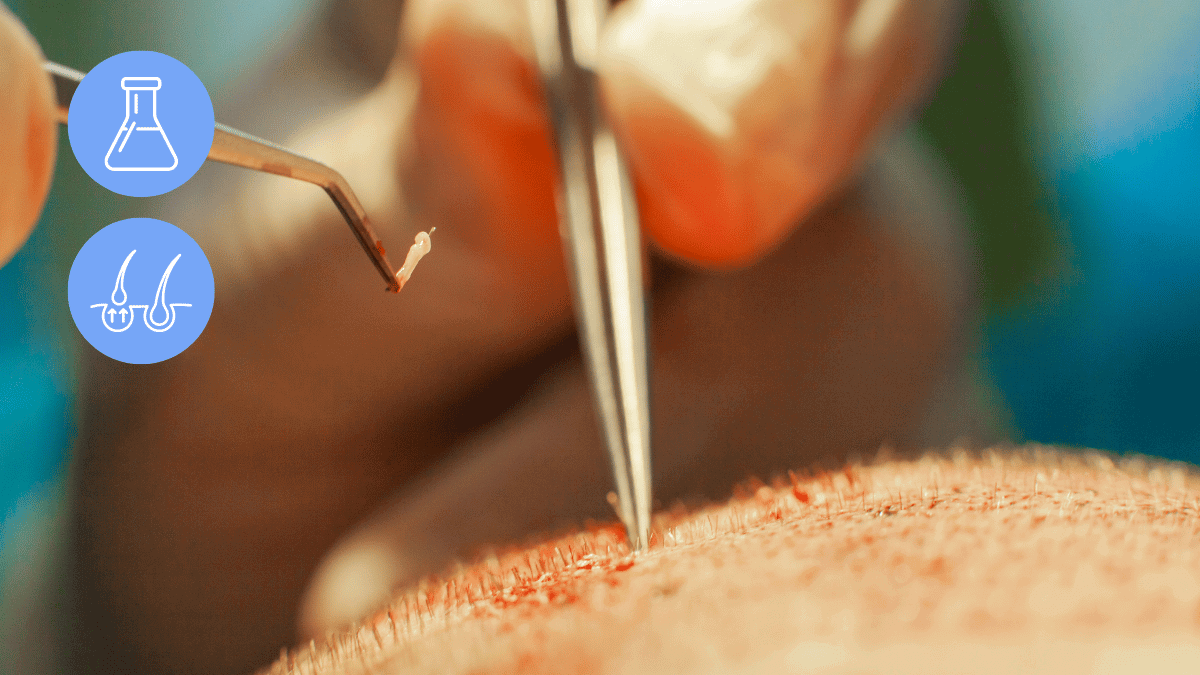First things first: You are on the right track.
You are doing great if you have already found your way into thorough research about hair transplant safety.
Because the key point for ensuring safety in hair transplant is information.
Patients often see the uncommon risks of a hair transplant because they are uninformed.
So, you got the first step right.
We are here to help you with the next: Learning the risks so you can avoid them.
In today’s article, I will present you the risks and possible side effects that may appear with a failed surgery and give you 3 steps for avoiding them:
Table of Contents
Let’s start with the side effects and possible failure scenarios:
All the Risks and Complications of Hair Transplant Surgeries 💊
No matter how rare they are, every hair transplant surgery has the risk of some side effects.
They can appear due patient’s medical history or the capabilities of the chosen clinic.
Whether they are a natural side effect or a failed surgery, the solution to both starts with learning about them.
So, to know what you are dealing with in the case of a hair transplant gone wrong, here are certain scenarios:
Infection
Like any other surgery with skin penetration, hair transplants have a chance to cause an infection in the area of surgery.
👉 The rate for it, however, is extremely low, appearing in only 1% of all patients.
These infections are usually mild and can be easily treated with antibiotics and regular scalp washing.
However, if it progresses further, an infection can cause the transplanted hair follicles to fall out and radically affect the effectiveness of the operation.
And if it goes untreated longer than that, it can spread deeper into the scalp tissue and bones, causing numerous diseases that could prove vital such as septicemia.
That is why you should pay attention to the early signs of a hair transplant infection.
⚠️ The top signs of a hair transplant infection are excessive redness and discoloration on the scalp, drainage, and a burning sensation.
The key word here is excessive. Because some amount of redness is expected and natural due to other side effects, such as bleeding or leaving scabs, which brings us to the next scenario:
Leaving scabs, crusts, or bleeding

During surgery, your scalp experiences some physical trauma, and, as a reaction, it lets through various fluids such as blood and edema.
These liquids quickly dry up after release and remain on your scalp as scabs or crust.
The whole process is your body’s natural healing process and is exactly the same as the crust forming around a wound when you injure yourself.
⚠️ The important part to focus on is scabs after a hair transplant should soften up and fall out a few days after the surgery, but you should consult your dermatologist if they are still solid around a week after the surgery.
🔔 One side note is that itching is another potential side effect that comes along with the crust.
It is expected and natural because the scabs and crust will form around the surgery site.
The itching should go away once the recipient and donor areas are healed, which should also take around a week.
⚠️ During that, you shouldn’t scratch your scalp or pick scabs under any circumstance since it’ll only worsen the situation, harm the healing process, and risk infections and poor results.
Swelling
Alternative to the previous scenario, if those bodily fluids cannot be properly released, you may experience swelling.
💡 A swelling usually appears around the forehead, eyelids, and face. Also, it may come with inflammation in the areas where your body is trying to release fluids.
It can begin 2-3 days following the surgery, as a ton of edema is produced in response to the micro-trauma caused by the incisions made during the surgery.
💠 But it shouldn’t last longer than 3 days on average.
Unfortunately, swelling differs drastically between patients.
⚠️ Some patients’ bodies can react mildly with minimal pain or severely with throbbing pain around their faces. But some might even have a hard time opening their eyelids. That is why it is harder to determine whether it is natural or due to an allergic reaction such as Anaphylaxis.
So, ideally, you should regularly follow your post-surgery check-ups to ensure that your doctor can take precautions early if necessary.
Hair rejection and shock loss
I have mentioned that an unnoticed and advanced level of infection can cause your transplanted hair follicles to fall out.
But this is a rare side effect not getting medical attention.
There are, however, two cases of complications when a hair transplant goes wrong that can also cause hair loss after surgery:
1️⃣ Hair rejections
2️⃣ Shock loss
Both are excessive hair loss scenarios, but shock loss is a natural reaction, while hair rejections are due to a failed hair transplant.
Hair transplant rejections appear due to poor hair treatment during and after the surgery.
The main reasons usually are either the patient not regularly showing care to their hair post-surgery (because their clinic did not inform them) or the clinic not paying proper attention.
⚠️ A hair transplant process is not limited to surgery alone, and entrusting your hair’s future to a clinic that believes it is, can cost you a lot.
👉 So, your key to survival in this scenario is, once again, choosing the right clinic through background research.
On the other hand, shock loss is an expected side effect.
Your scalp goes through severe stress during and following a hair transplant surgery as it experiences both incisions for retrieving and insertion.
Naturally, your body reacts to this stress, and in most cases, this reaction comes in the form of a sudden hair loss in the recipient area a few weeks following the surgery, which we call shock loss.
💠 But, for almost all cases, shock loss isn’t permanent, and new hair grows in the place of the fallen grafts.
In a few months, commonly around 6-8 months after the surgery, your new hair that fell out during shock loss too should grow and mature, contributing to your natural look.
🩺 Of course, it is always safest to regularly track your hair regrowth with your doctor.
Pain
Naturally, with this many reactions happening one after the other in your scalp, you will expectedly experience some pain.
💉 But your experience of hair transplant pain during surgery will be minimal, and even then, we can completely eliminate it by using anesthesia.
After that, you will again experience pain, tightness, and overall discomfort around your scalp the first few days following the surgery.
🍀 This is due to your body’s initial healing process.
But painkillers are prescribed especially for this period, so you will not experience much during these days.
Once you’re off the painkillers, you should still expect some pain and discomfort, but it is very mild for most patients.
⚠️ If the pain persists, however, you can continue with over-the-counter painkillers after consulting your doctor.
The overall pain experience can turn to numbness after surgery, depending on your body’s reaction or the persisting effects of anesthesia. But this, too, should not last longer than a few days.
🔔 One crucial point is that your pain can vary depending on your hair transplant method.
Most patients commonly experience higher pain in FUT, where grafts are harvested from a strip of tissue cut from the scalp.
👍 So, going for more modern and effective techniques such as DHI or Sapphire FUE can help you achieve a more pain-free smooth process.
Scars
Lastly, the side effect that appears at the final stages of your recovery post-surgery is hair transplant scars.
👉 Let’s clarify this: As of 2023, no hair transplant surgery is “entirely scarless.”
Even though the newest hair transplant techniques have drastically reduced scars, some will still be left.
So, the technique you choose is an important factor.
In FUE surgeries, tiny scars remain in the donor area after the follicles are harvested. These scars aren’t noticeable for most patients unless they are closely examined.
But, It’s a whole other story in FUT surgeries:
⚠️ The biggest downside of FUT surgeries compared to their better alternative, FUE, is undoubtedly the linear scar caused by strip transplants.
In a FUT surgery, the surgeon cuts a strip of tissue from the donor site, which holds the needed amount of hair grafts for the hair transplant.
Then, hair follicles are extracted from this separated tissue.
➡️ As the harvesting is done in a much more concentrated area and the skin tissue is extracted with the hair follicles, this extraction site leaves a scar.
This linear scar is, unfortunately, easily noticeable. So, most FUT patients have to grow their hair to a certain degree to hide it.
✅ So, just like pain, you can minimize the number of scars your body gains from your transplant surgery by choosing a more effective, advanced technique.
Alternatively, you should also keep in mind that a clinic that offers more advanced techniques is more likely to have more coordinated and knowledgeable doctors.
Yes, a scar is a part of your healing, but a wider scar may result from inadequate assessment of your donor area, which could lead to hair transplant failure.
💡 Better techniques accompany the credibility of clinics, and only with two can you achieve a successful hair transplant.
Speaking of which, let’s talk about what you can do to avoid these risks and ensure safety with the right clinic:
3 Steps to Ensure Patient Safety During a Hair Transplant ✅
Cooperation with your doctor provides a healthier and better future for your hair.
So, to achieve its safety, we must follow three steps.
Starting first with finding the clinic that is right for you:
1- Personal Pre-Surgery Consultation
💠 I have said that cooperation with your doctor is vital. So, the first step we take towards your healthy future should start with you.
To ensure you are in good hands, you should look for certain requirements in your chosen clinic.
First, doing background research on your clinic goes a long way. It would be very informative if they had a website or blog that lists their surgery process.
Make sure you choose a clinic and an expert surgeon that you trust with extreme hygiene measures.
🩺Also, as hair transplant surgery is within the field of dermatology, it must be done under the supervision of a dermatologist. So, do look for a clinic with an expert dermatologist that is present during the surgery.
Once you have decided on your clinic, your process will begin with a one-on-one consultation.
As I have repeated before, a hair transplant process does not end or begin with surgery.
🔔 That is why I should also remind you that your body is different and special. So, a thorough examination with your doctor about your medical background is essential.
Once you have consulted with your chosen and trusted doctor, you are in safe hands and ready to go for the second step:
2- Using Modern Techniques with Supplements
👉 This is the step where we make sure that the surgical part of the hair transplant process goes as effectively as possible.
And that is only possible by relying on the most advanced, modern, and clinically proven effective methods.
⚠️ Most patients with scarring on their scalp after a hair transplant have unfortunately undergone a FUT surgery.
Follicular Unit Transplantation will take less time and is mostly cheaper, but the risks of having side effects such as huge scars on the back of your scalp are significantly high.
Instead, you can prefer the FUE method, where the surgeon is more precise with the harvesting and implanting process to treat male pattern baldness.
👍 The FUE method also comes with more customization options depending on your scalp’s condition, such as a Sapphire FUE or the DHI method, which show fewer side effects in all cases than other hair transplant methods.
Lastly, a clinic that uses bio-enhancements during surgery is a big plus, as they highly increase the effectiveness of your transplant.
After you have decided on which method is the best for you and made sure that your chosen clinic can handle it, now is time for the last step:
3- Post-Surgery Follow-Up
➡️ I cannot stress this enough: The success of a hair transplant surgery is determined by the number of hair grafts left on your scalp after a 6-12 month period.
And that process is directly and vastly affected by your post-surgery care and follow-up.
So, you should pay attention to two things:
1️⃣ Whether your dermatologist doctor personally follows your hair’s process on a regular check-up routine.
2️⃣ And whether the clinic suggests supplement medication such as Finasteride or Minoxidil for keeping your hair healthy after the surgery.
If your clinic provides both requirements, you know what to do in the last step.
Simply ensure that you strictly follow the guidelines for post-hair transplant care your physician provides.
💠 The main key points are avoiding excessive sweating, swimming, and being present in polluted areas 30 days following the surgery.
You should also pay attention to not touching or scratching your scalp until the donor and recipient areas completely heal.
⚠️ If you feel you need to for any reason, just make sure your physician sees the condition of your scalp right away, just as you will do regularly to tell if there’s anything wrong.
So, the question is, where is that special clinic you’re looking for?
The right clinic that offers them all 🩺

At UnitedCare, we begin your hair transplant process by offering you a free one-on-one consultation with our expert doctors to find the best-suited option together.
Our holistic approach provides you with a mix of advanced technologies and bio-enhancements to ensure you do not need another surgery.
After you have decided on a method, we begin the treatment with the utmost attention. But most importantly, we stay in contact with our patients even long after the surgery has finished, ensuring that your transplant becomes permanent.
Affordable hair transplant costs, a holistic approach, and experienced dermatologists on-site are here to provide you with the right solution.
Ready to begin the journey? Click here to start the first step with a free consultation:
To ensure your safety, rely on the right clinic.
UnitedCare Clinic provide you with a Dermatosurgeon and a free consultation to be the right clinic:
Frequently Asked Questions (FAQs)
How often do hair transplants fail?
If you define hair transplant failure as not seeing an 80% or more survival rate in planted grafts, the failure rate for the average hair transplant (traditional FUE or FUT) would be between 5-10%. But, if you define failure as not achieving complete success in desired looks with a single surgery, the failure rate of hair transplant surgeries would be around 43%, according to ISHRS research which revealed that only 57% of patients achieve their desired results after a single hair transplant operation.
Are there any long-term side effects of hair transplants?
Every side effect of a hair transplant surgery tends to show different activity in terms of how long it will take for them to fade away. And the longest side effects, such as scars that appear after surgery, disappear between weeks to the first half of a year following your surgery.
What is the most dangerous risk of hair transplants?
There are many risks or complications of a hair transplant. With the right tools, every one of them can be lowered to a nonexistent risk, and alternatively, with poor care, each one can be quite dangerous to your hair’s health. At worst, we can at least say that you should watch out for infections, so hygiene is always vital.

